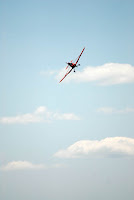

At some during my glider aerobatics adventure, my instructor mentioned that he and another 2 people own the Decathlon. “That Decathlon”- he said, pointing towards the yellow and blue plane that I initially thought to be another Citabria. Having almost jumped out of my skin at the thought of seeing my dream plane face to face, I asked if I could go look at it later. Instead, he extended me an offer to fly in it.


Just then I felt like I was at the gates of flying heavens: I got a chance to fly a glider, do acro in a glider and i was about to fly my dream airplane and may be even do some acro in it. My stomach tried to insert a meek “but you just did 20 mins and may not have it in you” in the endless stream of happy thoughts, but I told it to stuff it, we were going to fly that airplane even if it was straight and level.
It was not of course. Moving the glider back to starting position, finding parachutes (the ones we used in the glider stayed with the glider), visiting facilities, fuelling the plane, pre-flighting the plane all took time and my stomach settled enough that I knew I could do at least one acro figure and I wanted it to be the one that I have not flown before, but desperately wanted to experience with a qualified instructor on board.
Inverted spin.
It was incredible and not scary at all. To me, the rotations looked different than an upright spin, but that was probably because I knew we were inverted starting it. Had I not known, I’d probably not be able to differentiate inverted from upright. I would have loved to try one more, but I was concerned that it would leave little stomach tolerance for anything else, so we did other things instead.
I managed to fly a decent enough loop to hit my own wake, several somewhat ugly hammerheads (i never got truly vertical and forgot about aileron inputs in a turn) and some rolls. I mentioned to the instructor that I could never fly Citabria inverted for long enough due to extremely high stick force required to keep the nose up and next thing I know I was flying inverted in the Decathlon.
The Biggest difference between the Decathlon and Citabria is symmetrical airfoil in a Decathlon, making inverted flight MUCH EASIER. Keeping the nose above horizon was so easy that I decided to try turning (I never got to turning in a Citabria as I just was not able to keep the nose up long enough). Turning was funny as the plane turned opposite direction from upright for a given aileron input, but the rudder inputs were still the same as in upright, so while my brain knew all that, making it work inverted took some doing. Eventually, I rolled upright. Few moments later my stomach interrupted the flying Nirvana and asked to be delivered to the ground, pronto. We complied.
I got a little confused in the circuit with the power settings (it had a variable pitch prop that I never flown before), and had to slip almost all the way to landing, but managed an almost nice 3-pointer.Almost, because I pulled the stick back too fast and ballooned a bit. Saved by instructor, as usual.

And that was the end of the flying for that day, but I stayed on the field for couple more hours taking few pictures of the other people flying the Decathlon (used above); some unusual gliders and a lot of pictures of the tow planes. I was a perfect way to unwind after my double aerobatics.
Tow plane (Pawnee) coming to land:
Pawnee landing:
Glider tow:
Unusual (powered) glider:
I am definitely coming back there. Soon.

















